BUICK PARK AVENUE 1994 Owners Manual
Manufacturer: BUICK, Model Year: 1994, Model line: PARK AVENUE, Model: BUICK PARK AVENUE 1994Pages: 324, PDF Size: 17.01 MB
Page 91 of 324
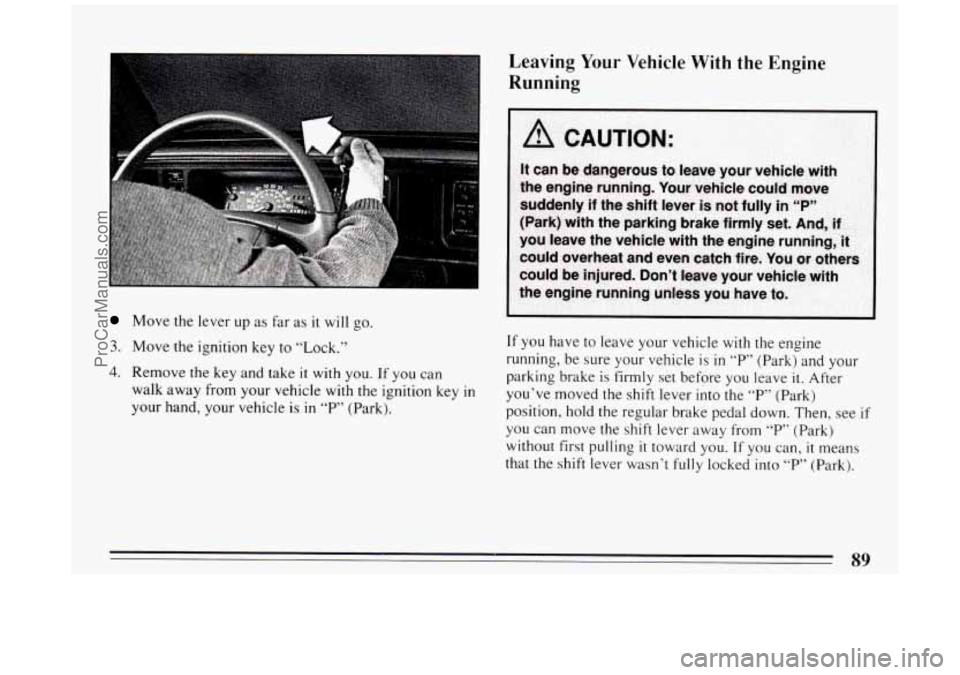
Move the lever up as far as it will go.
3. Move the ignition key to “Lock.”
4. Remove the key and take it with you. If you can
walk away from
your vehicle with the ignition key in
your hand, your vehicle is in “P” (Park).
Leaving Your Vehicle With the Engine
Running
If you have to leave your vehicle with the engine
running, be sure your vehicle
is in “P” (Park) and your
parking brake
is firmly set before you leave it. After
you’ve moved the shift lever into the
“P” (Park)
position, hold the regular brake pedal down. Then, see
if
you can move the shift lever away from “P” (Park)
without first pulling
it toward you. If you can, it means
that the
shift lever wasn’t fully locked into “P” (Park).
89
ProCarManuals.com
Page 92 of 324
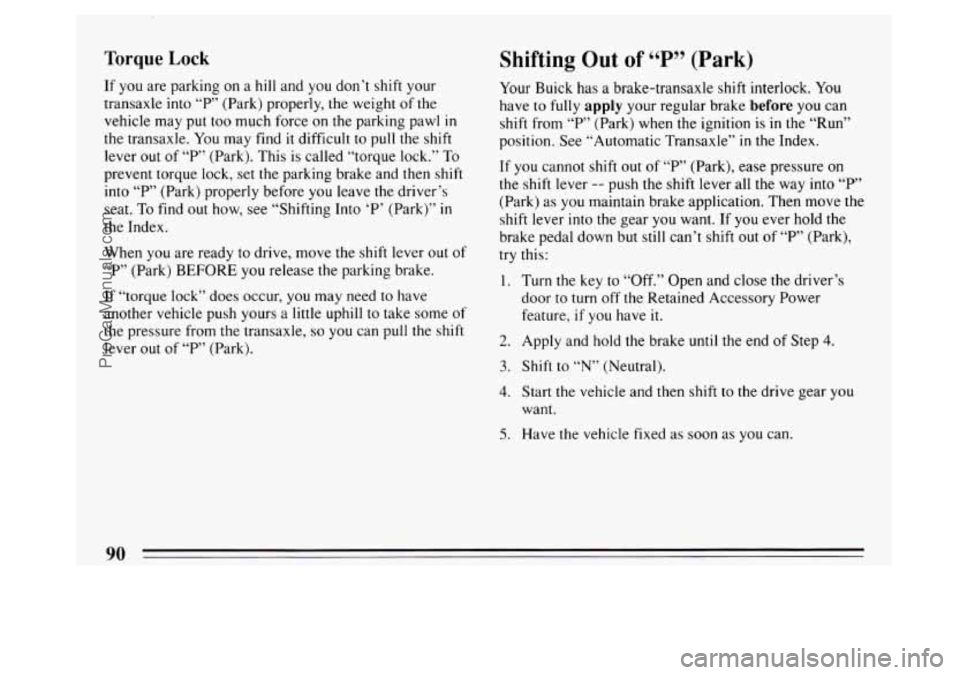
Torque Lock
If you are parking on a hill and you don’t shift your
transaxle into
“P’ (Park) properly, the weight of the
vehicle may put too much force on the parking pawl
in
the transaxle. You may find it difficult to pull the shift
lever out of
“P’ (Park). This is called “torque lock.” To
prevent torque lock, set the parking brake and then shift
into “P” (Park) properly before you leave the driver’s
seat.
To find out how, see “Shifting Into ‘P’ (Park)” in
the Index.
When
you are ready to drive, move the shift lever out of
“P” (Park) BEFORE you release the parking brake.
If “torque lock” does occur, you may need
to have
another vehicle push yours
a little uphill to take some of
the pressure from the transaxle,
so you can pull the shift
lever out of “P’ (Park).
Shifting Out of P (Park) 66 99
Your hick has a brake-transaxle shift interlock. You
have
to fully apply your regular brake before you can
shift from
“P’ (Park) when the ignition is in the “Run”
position. See “Automatic Transaxle”
in the Index.
If you cannot shift
out of T“ (Park), ease pressure on
the shift lever
-- push the shift lever all the way into “P”
(Park) as you maintain brake application.
Then move the
shift lever into the gear you want. If
you ever hold the
brake pedal down but still can’t shift out of
“P” (Park),
try this:
1, Turn the key to “Off.” Open and close the driver’s
door
to turn off the Retained Accessory Power
feature,
if you have it.
2. Apply and hold the brake until the end of Step 4.
3. Shift to “N” (Neutral).
4. Start the vehicle and then shift to the drive gear you
5. Have the vehicle fixed as soon as you can.
want.
ProCarManuals.com
Page 93 of 324
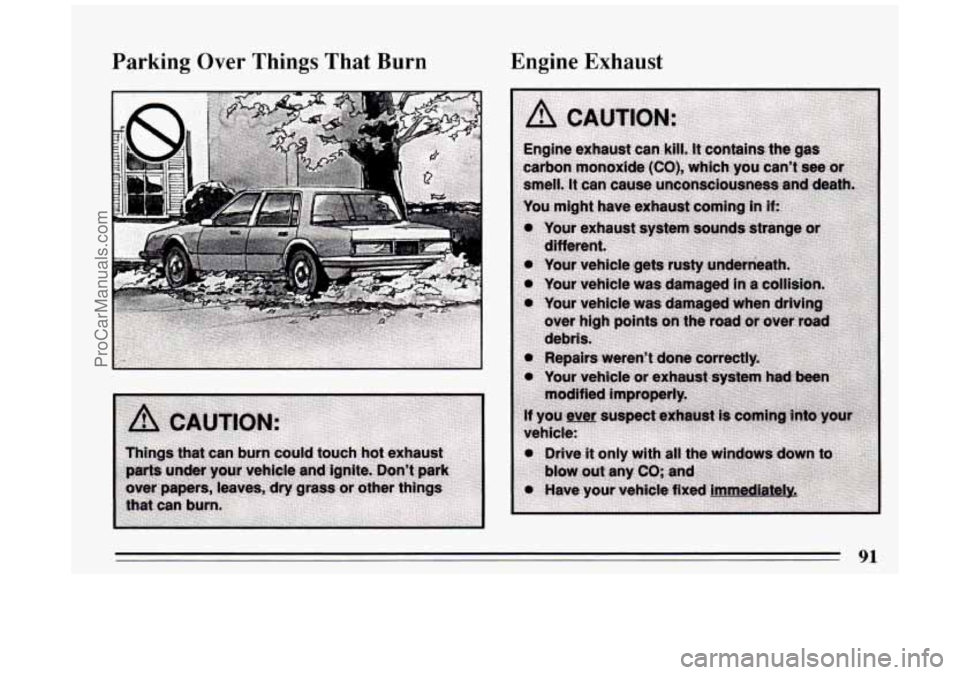
Parking Over Things That Burn Engine Exhaust
91
ProCarManuals.com
Page 94 of 324
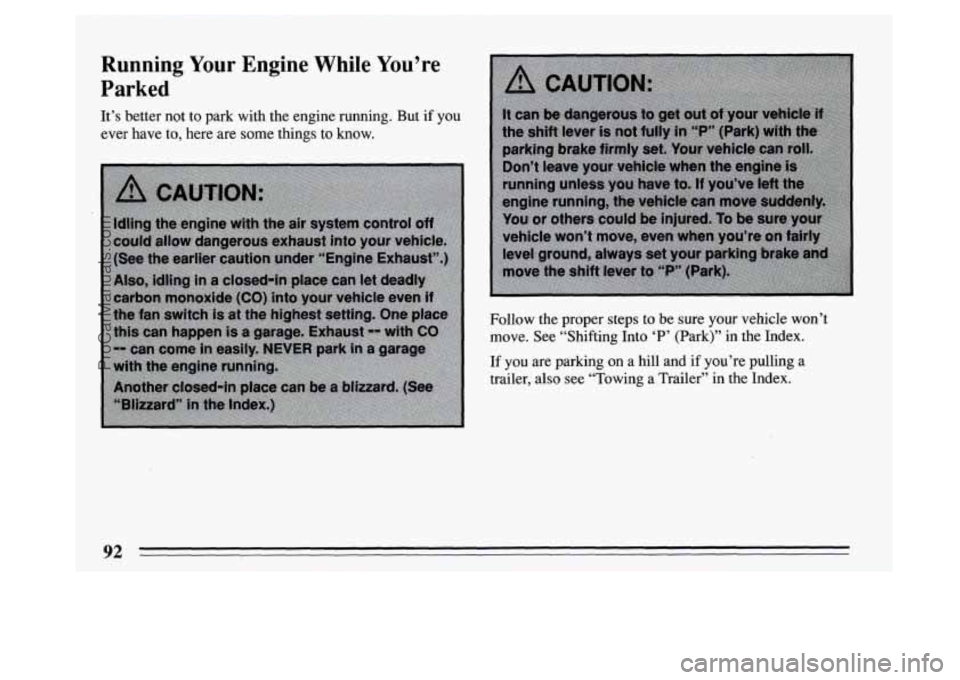
Running Your Engine While You’re
Parked
It’s better not to park with the engine running. But if you
ever have to, here are some things to know.
Follow the proper steps to be sure your vehicle
won’t
move. See “Shifting Into ‘P’ (Park)” in the Index.
If you are parking on a hill and if you’re pulling a
trailer, also see “Towing a Trailer” in the Index.
ProCarManuals.com
Page 95 of 324
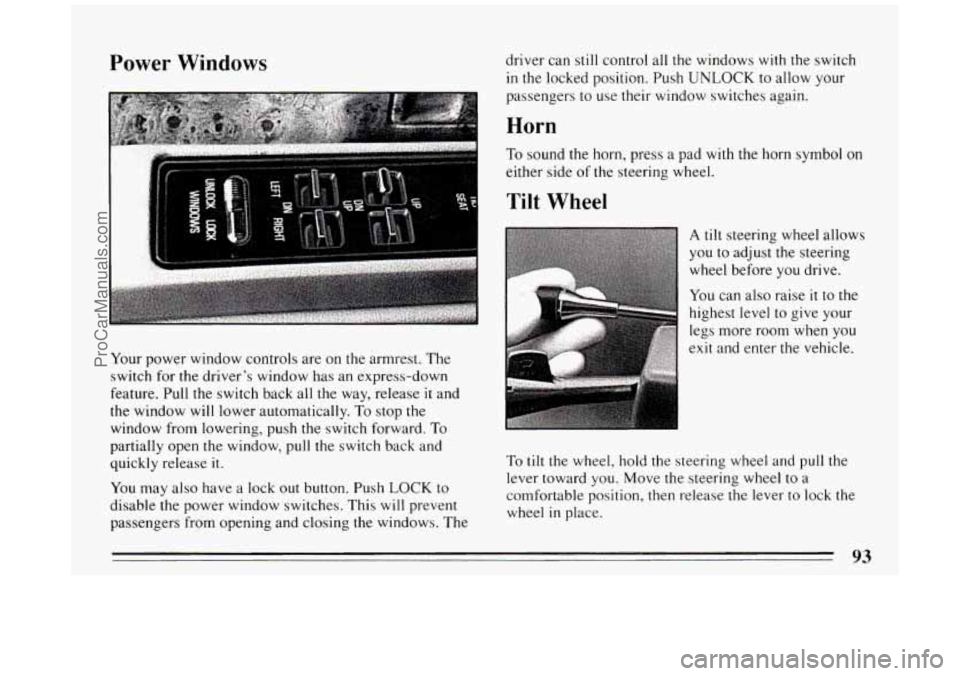
Power Windows
Your power window controls are on the armrest. The
switch for the driver’s window has an express-down
feature. Pull
the switch back all the way, release it and
the window will lower automatically.
To stop the
window from lowering, push the switch forward.
To
partially open the window, pull the switch back and
quickly release it.
You may also have a lock out button. Push
LOCK to
disable the power window switches. This
will prevent
passengers from opening and closing the windows. The driver
can still control all the windows
with the switch
in
the locked position. Push UNLOCK to allow your
passengers to use their window switches again.
Horn
To sound the horn, press a pad with the horn symbol on
either side of the steering wheel.
Tilt Wheel
A tilt steering wheel allows
you to adjust the steering
wheel before you drive.
You can also raise
it to the
highest level to give your
legs more room
when you
exit and enter
the vehicle.
To tilt the wheel, hold the steering wheel and pull the
lever toward
you. Move the steering wheel to a
comfortable position, then release the lever to lock the
wheel
in place.
93
ProCarManuals.com
Page 96 of 324
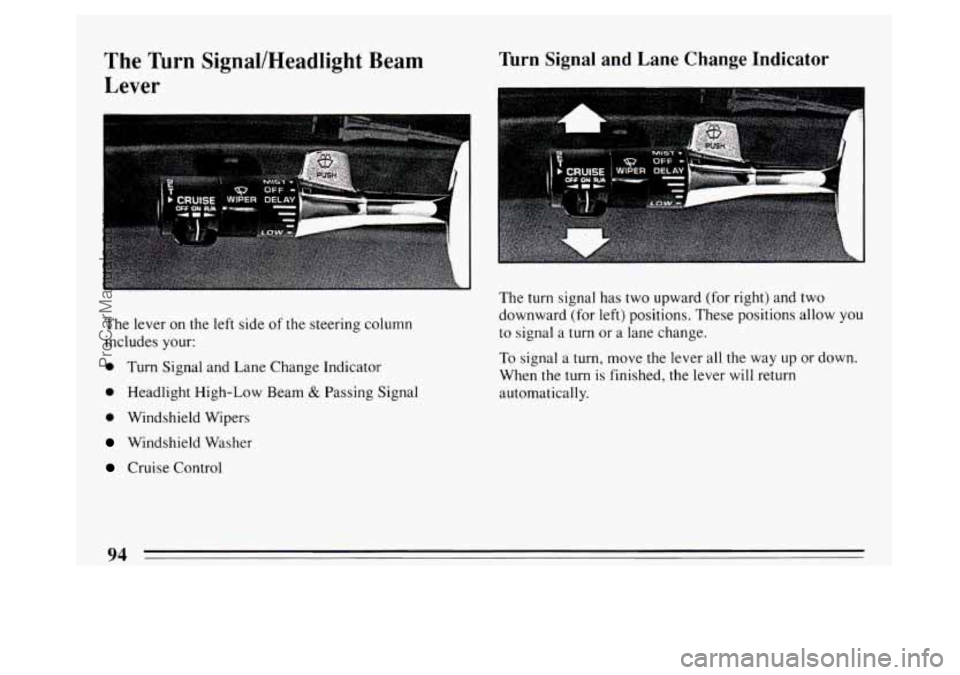
The Turn SignallHeadlight Beam
Lever
The lever on the left side of the steering column
includes your:
0 Turn Signal and Lane Change Indicator
0 Headlight High-Low Beam & Passing Signal
0 Windshield Wipers
Windshield Washer
Cruise Control
Turn Signal and Lane Change Indicator
I'
The turn signal has two upward (for right) and two
downward (for left) positions. These positions allow
you
to signal a turn or a lane change.
To signal a turn, move the lever all the way
up or down.
When the turn
is finished, the lever will return
automatically.
94
ProCarManuals.com
Page 97 of 324
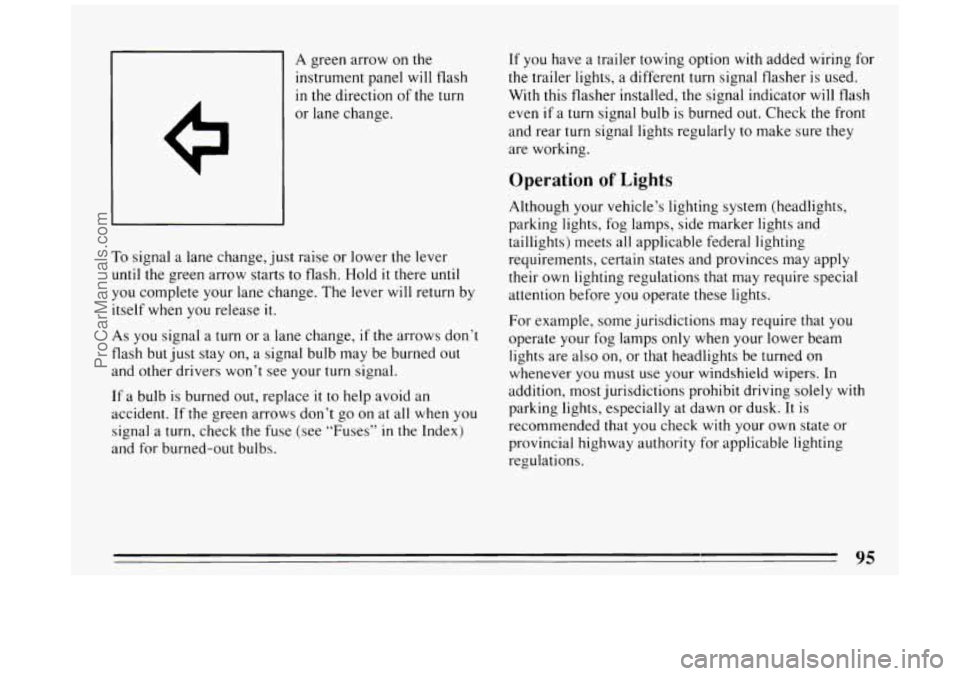
A green arrow on the
instrument panel will flash
in the direction of the turn
To signal a lane change, just raise or lower the lever
until the green arrow starts to flash. Hold it there until
you complete your lane change. The lever will return by
itself when you release
it.
As you signal a turn or a lane change, if the arrows don’t
flash but just stay on, a signal bulb may be burned out
and other drivers won’t see your turn signal.
If a bulb is burned out, replace it to help avoid an
accident. If the green arrows don’t go on at all when you
signal a
turn, check the fuse (see “Fuses” in the Index)
and for burned-out bulbs. If you
have a trailer towing option
with added wiring for
the trailer lights, a different turn signal flasher is used.
With this flasher installed, the signal indicator
will flash
even
if a turn signal bulb is burned out. Check the front
and rear turn signal lights regularly to make sure they
are working.
Operation of Lights
Although your vehicle’s lighting system (headlights,
parking lights, fog lamps, side marker lights and
taillights) meets all applicable federal lighting
requirements, certain states and provinces may apply
their own lighting regulations that may require special
attention before you operate these lights.
For example, some jurisdictions may require that you
operate your fog lamps only when your lower beam
lights are also on, or that headlights be turned on
whenever you must
use your windshield wipers. In
addition, most jurisdictions prohibit driving solely
with
parking lights, especially at dawn or dusk. It is
recommended that you check with your own state or
provincial highway authority for applicable lighting
regulations.
95
ProCarManuals.com
Page 98 of 324

Headlight High-Low Beam
BRIGHT
Windshield Wipers
To change the headlights
from low beam to high or
high to low,
pull the turn
signal lever toward you.
Then release
it. When the
high beams are on, this blue
light on the instrument
panel also will be on. You
control the windshield wipers by turning the band
marked
“WIPER.”
For a single wiping cycle, turn the band to “MIST.”
Hold
it there until the wipers start, then let go. The
wipers will stop after one cycle. If you want more
cycles, hold the band on “MIST” longer.
You can set the wiper speed for a long or short delay
between wipes. This can be very useful
in light rain or
snow. Turn the band to choose the delay time. The
closer to
“LOW,” the shorter the delay.
For steady wiping at low speed, turn the band away
from you to the
“LOW” position. For high speed
wiping, turn the band further,
to “HIGH.” To stop the
wipers, move the band to “OFF.”
Remember that damaged wiper blades may prevent you
from seeing well enough to drive safely.
To avoid
damage, be sure to clear ice and snow from the wiper
blades before using them. If they’re frozen to
the .
windshield, carefully loosen or thaw them. If your
blades become damaged, get new blades or blade
inserts.
Heavy snow or ice can overload your wiper motor.
A
circuit breaker will stop the motor until it cools. Clear
away snow or ice to prevent an overload.
96
ProCarManuals.com
Page 99 of 324
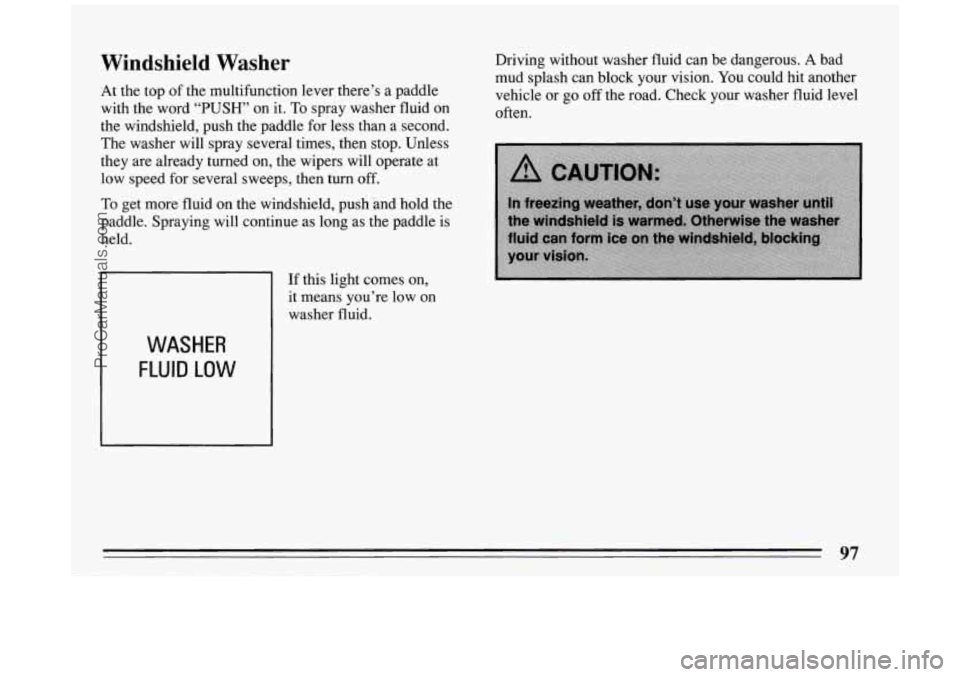
Windshield Washer
At the top of the multifunction lever there’s a paddle
with the word “PUSH” on it. To spray washer fluid on
the windshield, push the paddle for less than a second.
The washer will spray several times, then stop. Unless
they are already turned
on, the wipers will operate at
low speed for several sweeps, then turn
off.
To get more fluid on the windshield, push .and hold the
paddle. Spraying will continue as long as the paddle is
held.
WASHER
FLUID LOW
If this light comes on,
it means you’re low on
washer fluid. Driving
without washer fluid can be dangerous.
A bad
mud splash can block your vision.
You could hit another
vehicle or go
off the road. Check your washer fluid level
often.
97
ProCarManuals.com
Page 100 of 324

NOTICE:
When using concentrated washer fluid,
follow the manufacturer’s instructions for
adding water.
0 Don’t mix water with ready-to use washer
fluid. Water can cause the solution to
freeze and damage your washer fluid tank
and other parts
of the washer system. Also,
water doesn’t clean as well as washer fluid.
0 Fill your washer fluid tank only 3/4 full
when it’s very cold. This allows for
expansion, which could damage the tank
if
it is completely full.
windshield washer. It can damage your
paint.
Don’t use radiator antifreeze in your
Cruise Control
1
With Cruise Control, you
can maintain a speed
of
about 25 mph (40 km/h) or
more without keeping your
foot on the accelerator. This
can really help on long
trips. Cruise Control does
not work at speeds below
about
25 mph (40 km/h).
When you apply your brakes, the Cruise Control shuts
off.
98
ProCarManuals.com